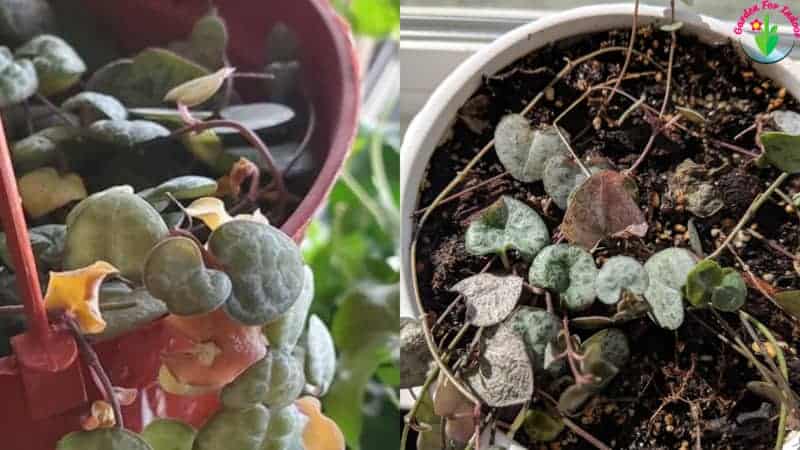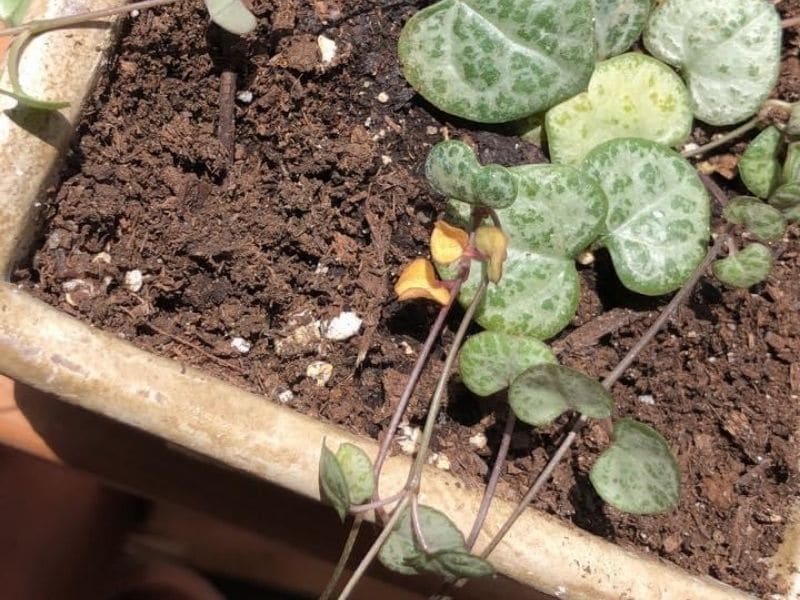
Water string of hearts plants with a generous soak then wait for the soil to dry out completely before watering again. In order to meet the string of hearts plants’ water needs without causing root rot, watering them once every two weeks usually allows the soil to dry out after watering.
It is important to know how often and how much to water string of hearts plants (Ceropegia woodii variegata) as the are drought resistant plants that are susceptible to root rot which is caused by over watering and slow draining soils.
Because they are dormant during the winter, string of hearts require less watering.
To avoid water stress and maintain the health of your string of hearts plant, the ideal watering schedule should be used in conjunction with the well-draining, succulent soil and the appropriate pot.
Continue reading to learn more about choosing the right potting soil and determining how frequently and how much to water your string of hearts plant based on your climate and environmental factors.
Table of Contents
How Often to Water String of Hearts
String of hearts plants are succulents that are specially adapted to growing in hot and dry climates with infrequent rainfall.
Due to their adaptation to drought, string of hearts plants prefer dryer conditions than the majority of houseplants and are more vulnerable to the negative effects of frequent watering, such as yellowing of the leaves and stems and root rot.
To grow string of hearts successfully in your home or garden it is important to replicate the typical watering and soil moisture conditions of their native environment.
When the potting soil is totally dry, give string of hearts plants a good soak. String of hearts should typically be watered once every 14 days to meet the plant’s moisture needs and give the soil time to fully dry out before another watering in order to prevent root rot.
However the potting soil for string of hearts plants can dry out at different rate due to the climate and indoors conditions due to several factors:
- Humidity level and temperature of your climate.
- How big the pot is (smaller pots dry out much quicker).
- Whether your string of hearts is in an area of significant air flow, outdoors or because of air currents from, air conditioning or forced air when indoors.
- the soil’s ability to hold onto moisture.
To establish how often to water string of hearts, according to your climate, feel the soil at the bottom of the pot through the drainage hole. If the soil feels moist then do not water just yet, but if the soil feels dry, this is the perfect time for watering.
Once you know how long it typically takes for the potting soil to dry out from your string of hearts, you can establish a watering schedule that accurately emulates the drought, followed by rainfall, cycle of moisture of the string of hearts native Southern African environment.
How to Tell if you are Watering String of Hearts too Often
You’re probably overwatering your string of hearts plant if you’re watering it more frequently than once per week.
The symptoms of an over watered string of hearts are leaves that turn brown yellow, translucent and eventually black which is an indication of rot. The stems can also feel mushy.
If your string of hearts is showing symptoms of over watering then scale back the watering immediately and let the soil dry out completely to give your plant a chance to recover.
(Read my post on how to resuscitate a dying string of hearts plant if your string of hearts plant appears to be in poor health.)
How to Tell if you are Watering String of Hearts not Often Enough

The leaves can also appear to be thinner as the moisture they store becomes depleted due to drought stress.
This is much easier to solve the over watering as giving the potting soil a thorough soak might save your string of hearts plant.
Wait for the soil to dry out again over the next 2 or 3 weeks and then soak it again.
The string of hearts should start to recover after two watering cycles, and the leaves should feel firm and appear plump rather than shriveled.
It’s also important to keep in mind that depending on the season, string of hearts may need more or less watering.
How Often to Water String of Hearts in Winter
During the winter, water string of hearts plants once every three to four weeks. Because string of hearts is a dormant plant, it needs less watering than in the spring and summer.
String of hearts goes into dormancy in response to shorter daylight hours, less intense light, and colder weather.
During the Winter dormancy the string of hearts plant barely grows if at all which reduces the demand for water.
String of hearts is at more risk of over watering during dormancy and it is easier to revive an under watered string of hearts then an over watered plant so scale back the watering.
However it is important to consider whether the string of hearts plant is near a source of heat during Winter which can cause daily temperatures to fluctuate significantly and dry out the soil more quickly.
If the leaves start to look shriveled (a sign of under watering) then give the string of hearts plant a generous soak.
As long as the soil has a chance to dry out between watering then the string of hearts plant should stay healthy.
(Read my article how to care for string of hearts plants for all the best practices for care).
How Much Water to Use When Watering String of Hearts
Always water string of hearts with a generous soak so that excess water trickles from the base of the pot.
Whilst the variables of environment, humidity and temperature can all influence how often to water string of hearts plants, the amount of water should stay the same.
Always watering string of hearts generously, ensures that the water has infiltrated the soil properly so that the roots of the plant can uptake the moisture they require.
A good soak encourages root to develop properly and keeps the string of hearts healthy.
Watering too lightly leads in only the top inch or so of the soil being moist and the water does not reach the roots where it is required which causes the string of hearts plant leaves to shrivel and eventually turn brown as an indication of drought stress.
(It should be noted succulents sometimes shrivel when over watered as well as under watered so read my article for how to tell the difference).
Watering with a good soak then allowing the soil to dry out replicates the watering conditions of the string of hearts plants natural environment in Southern Africa with a deluge of rain followed by a period of drought and high temperatures.
Well Draining Soil to Avoid Over Watering
To prevent root rot, string of hearts plants should be planted in a soil mixture that drains well along with good watering practices.
Ordinary potting soil retains too much moisture around the roots for the string of hearts which is adapted to tolerate drought rather then live in damp soil.
The leaves may turn yellow as a sign of stress in saturated soil.
Peat-based potting mixtures also have a propensity to reject water when they become dry, which causes water to run off the soil’s surface and prevents moisture from getting to your string of hearts plant’s roots, which causes the leaves to shrink under the stress of dehydration.
String of hearts plants grow naturally in sandy or gritty soil on hill sides in Southern Africa, in soil that drains well and does not hold much moisture.
Growing string of hearts plants in specialized succulent and cactus potting mix (available from garden centers and Amazon) is essential for maintaining the string of hearts plant’s health and preventing root rot. This is because it replicates the unique well-draining soil characteristics and soil profile of a string of hearts plant’s native environment.
With the proper soil, it is much simpler to keep string of hearts plants’ ideal moisture balance and avoid any negative effects of overwatering, such as the roots and tubers rotting, keeping your plant healthy.
Water String of Hearts in Pots and Containers with Drainage Holes in the Base

Watering such that excess water trickles out the bottom of your pot is also the best to to guarantee your plant has been appropriately watered and an excellent way to identify whether the soil is moist or dry at the bottom of the pot to so you know when your string of hearts plant should be watered.
When string of hearts are planted in pots and containers without drainage holes in the base, water collects around the roots, leading to root rot and yellow leaves.
When your plant is in a pot, water may still collect around the roots if:
- The drainage hole becomes blocked with roots or compacted soil. If you observe your soil draining slowly then it is worth investigating whether you should clear the hole in the base to allow excess water to leave correctly.
- Saucers and trays underneath your pots. It is fairly normal to use a saucer or tray underneath your plant pot to prevent water overflowing in your home. Empty the saucer or tray regularly to prevent water pooling and keeping the soil too boggy for your string of hearts plant.
- outside pots that add style. String of hearts plants are often sold in a plastic pot with drainage holes but put in a decorative outer pot which looks good and prevents water from spilling in your home. However the outer pot prevents excess water escaping and keeps the soil too damp which causes root rot, so either empty the pot of water regularly or plant in a pot with drainage holes in the base.
Key Takeaways:
- When watering string of hearts plants, give them a good soak and then wait until the soil is completely dry. Typically this means watering string of hearts plants once every 2 weeks. In the winter, when the plant is dormant, water string of hearts once every three to four weeks.
- String of hearts plants should be planted in special succulent and cacti soil which is formulated to recreate the drainage conditions and soil nutrients of their native environment for the string of hearts plant to stay healthy.
- To avoid excess water collecting around the roots and resulting in root rot, string of hearts plants should be planted in pots and containers with drainage holes in the base.
- When a string of hearts is underwatered, the leaves become shriveled and turn brown; when it is overwatered, the leaves turn yellow and the stems and leaves become mushy. Water string of hearts plants after the soil has tried out fully to avoid root rot.
